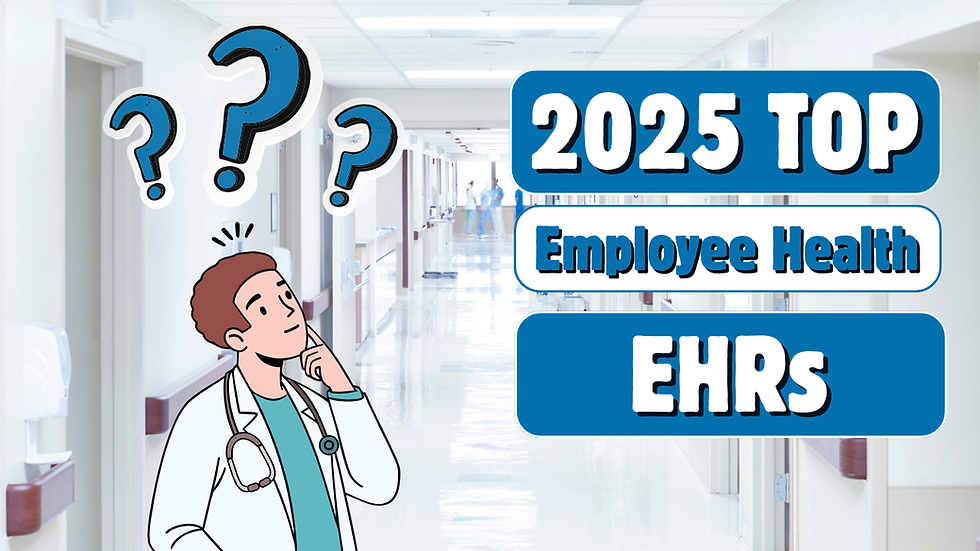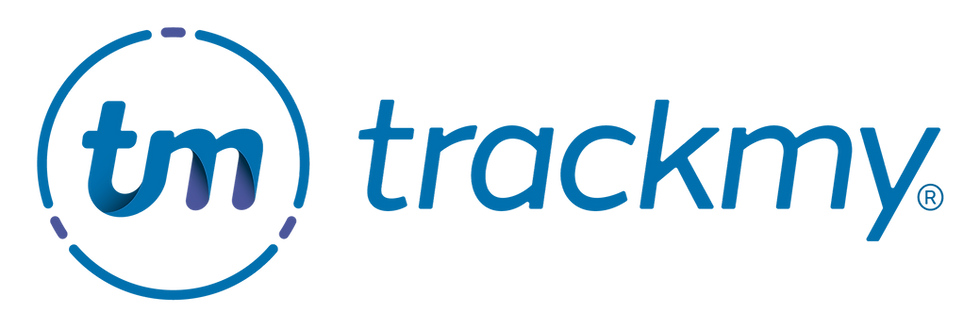2025 Top Employee Health EHRs - for Healthcare Organizations
- TrackMy's ACC

- Aug 4
- 5 min read

Top Employee Health EHRs
When it comes to employee health software, the reality is frustrating. Platforms still feel outdated, support is slow, and customization often comes at a steep cost. Because of this, many organizations are still relying on manual processes and even paper documentation to get through critical employee health workflows. It's not that employee health EHR options don't exist, it's that very few of them were designed with specific employee and occupational health workflows in mind, such as fit testing or NHSN reporting. Workflows like these and many others do not exist in patients facing EHRs such as Epic, Cerner, Meditech, and many others.
That's why we created this list. Whether you're part of a hospital, FQHC, Critical Access Hospital, Community/Regional Hospital, or Academic Medical Center we wanted to break down the top employee health EHR options that are out there. While all platforms made our list for a reason, we encourage you to pay close attention to the top rated ones, based on customer feedback and publicly available information. They offer the best chance at streamlining employee health compliance, easing documentation, and actually making your team's life easier.
1. TrackMy

TrackMy claims the top spot due to it genuinely being built for organizations of every size. The platform has helped tiny rural clinics, sprawling multi-hospital systems, and even statewide public-health programs meet tough compliance goals. Pair that scale with a personable, phase-based client-success strategy and it’s hard to imagine a setting where TrackMy can’t deliver. Founded in 2020 by former Cerner and Epic employees, TrackMy was built by professionals who had spent decades in hospitals, higher education, and public health departments.
Key features:
Automated vaccine verification and real-time compliance tracking
Automated medical review for fit testing
Highly customizable to meet organizational needs
Out of the box regulatory reporting (i.e. NHSN)
Dashboards designed for audits, reporting, and population health
Tools for managing declinations, exemptions, and scheduling
Top tier client success strategy, built with the client in mind
Things to consider:
It is easily integratable with existing EHRs and SIS systems.
Client Success team does an amazing job with helping clients meet & maintain their compliance goals
Ideal for: Employee health, higher education, and public health teams of all sizes seeking a modern, high-touch EHR built for their workflows.
2. Meditrax
Meditrax earns the #2 spot as a dependable, budget-friendly alternative for employee health tracking. It has been trusted by many organizations over the years for immunization tracking, compliance reporting, and basic surveillance management. However, it is not cloud-based and typically requires in-house IT support for maintenance, updates, and hosting.
Best from a budget perspective, Meditrax is often used by organizations seeking a reliable system without the cost of larger cloud-based platforms. That said, the lack of a modern interface or scalable infrastructure can present challenges for growing health systems.
Key features:
Centralized tracking of vaccines, titers, and TB tests
Tools for onboarding documentation and surveillance reporting
Custom reports for audits and compliance reviews
Works offline or via on-premise hosting
Things to consider:
Not cloud-hosted requires internal server hosting and dedicated IT support
Limited interface modernization and automation
Customization and implementation can take time depending on local support
Best for organizations that already have strong internal IT resources
Ideal for: Budget-conscious organizations that are okay with an outdated UI. Must have internal IT support to manage servers and break/fix.
3. PureOHS
PureOHS ranks #3 for its specialized focus on occupational health. Developed by UL Solutions, this cloud-based platform is purpose-built for managing workplace health documentation, incidents, and compliance. Like many of the previous companies it is full-scale EHR, it offers trusted tools for occupational health and OSHA documentation workflows, making it a dependable choice for employer clinics and industrial health programs.
Key features:
Purpose built for occupational health: incident tracking, real-time documentation, case management, and structured billing
Audit-ready compliance and OSHA reporting tools
Designed to streamline manual to digital workflows in clinic or industrial health trending
Things to consider:
Focus is on occupational health, not comprehensive patient care
It has a more modern UI
While PureOHS is a purpose built EMR, its parent company UL Solutions also deals with a lot of other solutions which may affect the level of importance they put into the PureOHS product offering.
Ideal for: Corporations or clinics needing occupational health and clinic-level documentation systems, especially those managing workplace injuries, exposures, and compliance.
4. Immuware by Propelus
Immuware lands at our 4th spot. Based in Chicago, IL, Immuware is a cloud platform focused on employee and occupational health compliance, including immunizations, screenings, incident tracking, and training. Users trust its secure record-keeping and self-service dashboards, but heavy reliance on employees to manually upload records is a frustrating topic for users. It is a complete employee health EMR, which organizations leverage in its full capacity.
Key features:
Real-time dashboards for vaccines, exposures, screenings, and certifications
Employee self-service portal to upload records, sign forms, and track compliance status
Azure-based cloud hosting with enterprise-grade security
Things to consider:
Not fully paperless: Staff must manually upload documents; no integrated e-form capture.
Since recently being acquired, clients have expressed dissatisfaction with turn around times and customer support. Some organizations have also report inconsistent communication.
Hefty Implementation fees. Also, several organizations have expressed difficulties in the implementation process with Immuware. These organizations cited implementation taking almost two years which was well over the anticipated timeline.
Ideal for: Mid-sized organizations such as community or regional hospitals.
5. Enterprise Health
Enterprise Health combines occupational health and employee health into one integrated solution. It is an EHR that offers EHS functionality while also being ONC-certified and capable of managing patient-facing workflows. Headquartered in Fort Wayne, Indiana, Enterprise Health was originally developed to serve large-scale healthcare and government organizations.
Key features:
Unified occupational health and clinical care platform
Built-in tools for immunization compliance, surveillance, and exposure tracking
Integration capabilities with HRIS, EHR, and claims systems
AI-Powered Capabilities
Things to consider:
Tailored more toward large enterprises or government-level deployments
Interface and navigation can feel complex to new users
Cost structure may be prohibitive for smaller facilities (FQHCs & Community Hospitals)
Limited flexibility in customizing niche workflows without heavy involvement from their development team
Ideal for: Large employers, health systems, or government agencies seeking a robust, integrated system for both occupational health and patient-facing care.
6. Cority ReadySet
Cority ReadySet, headquartered in Toronto, Canada, serves many mid-sized to large healthcare organizations and offers solid functionality. While it is a known name in the employee health EHR market, customers have voiced inconsistent customer support and “nickel and diming” for enhancements that should already be a part of the platform. Worth noting, customers experience the before mentioned after its acquisition. From a technology perspective, Cority ReadySet is a cloud-based platform focused on environmental, health, and safety (EHS) compliance, widely used in both healthcare and corporate sectors. While its employee/occupational health module is adequate, it lacks automation desired by both HR and clinical teams compared to the clinical depth and service reliability seen in higher-ranked systems.
Key features:
Incident management, audit readiness, and training tracking
Employee health and wellness documentation tools
Clinical Documentation
Risk Management
Things to consider:
Mixed feedback on customer service responsiveness
Better suited for mid-sized to large organizations with large IT teams
Lacks deep specialization in new-hire onboarding workflows
Hefty Implementation fees.
Ideal for: Mid-sized to large organizations who have a large IT team to support the solution. A plus for organizations tracking environmental services.
Choosing the Right Employee Health EHR is Critical
Choosing the right employee health EHR isn’t just a technology decision. It’s a strategic one. The right platform should align with your organization’s size, goals, and workflows while helping your health teams work more efficiently and stay ahead of compliance requirements. Whether you're managing immunizations, fit testing, or NHSN reporting, a purpose-built EHR can reduce manual processes, improve data accuracy, and support healthier outcomes across your workforce.
Pick a solution that sets your team up for success from day one, not one that forces you to work around its limitations
.png)
Comments